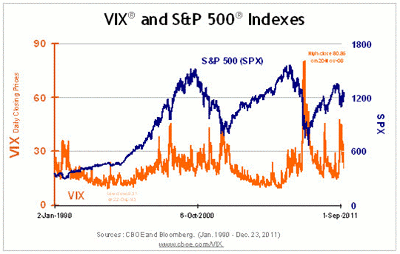VIX options directly isolate volatility, trade in a range, have high volatility of their own, and cannot go to zero, making them very worthwhile trading vehicles, writes Chris McKhann of Investopedia.com.
Trading volatility is nothing new for option traders. Most rely heavily on volatility information to choose their trades, and for this reason, the Chicago Board Options Exchange (CBOE) Volatility Index (VIX) has been a popular trading tool for option and equity traders since its introduction in 1993.
Until recently, traders used regular equity or index options to trade volatility, but many quickly realized that this was not the best method. On Feb. 24, 2006, the CBOE rolled out options on the VIX, giving investors a direct and effective way to use volatility. In this article, we take a look at the past performance of the VIX and discuss the advantages offered by the VIX options.
What Is the VIX?
The VIX is an implied volatility index that measures the market's expectation of 30-day S&P 500 volatility implicit in the prices of near-term S&P options. VIX options give traders a way to trade volatility without having to factor in the price changes of the underlying instrument, dividends, interest rates or time to expiration-factors that affect volatility trades using regular equity or index options. VIX options allow traders to focus almost exclusively on trading volatility.
See related: VIX: What It Is (and Is Not)
Diversification
Traders have found the VIX very useful in trading, but now it provides superb opportunities for both hedging and speculation. It may also be an excellent tool in the quest for portfolio diversification.
Diversification, which most people consider a good thing, is useful only if the instruments used are not correlated. In other words, if you own ten stocks and they tend to move together, then you really aren't diversified at all.
One advantage of the VIX is its negative correlation with the S&P 500. According to the CBOE's own Web site, since 1990, the VIX has moved opposite the S&P 500 Index (SPX) 88% of the time. On average, VIX has risen 16.8% on days when SPX fell 3% or more. This makes it an excellent diversification tool and perhaps the best market disaster insurance.
See related: Using Options as Portfolio Insurance
Buying VIX calls seems to be an even better hedge against drops in the market (S&P) than buying SPX puts. The chart in Figure 1 below shows how the VIX moves in opposition to the SPX in big moves down for SPX. In 2008, the VIX reached its highest close at 80.86.
As you can see in Figure 1, the VIX trades within a given range. It bottoms out around 10, because if it were to go to zero, that would mean that the expectation was for no daily movement in the SPX.
On the other hand, the VIX has spiked upward to around 80 when the SPX has dropped, but for the VIX to stay there would mean that the market expectation was for very large changes over an extended time frame.
This makes the new VIX options excellent speculation instruments as well. Buying calls (or bull call spreads, or selling bull put spreads) when the VIX bottoms out can help a trader capitalize on moves up in volatility, or down in the S&P 500.
Similarly, buying puts (or bear put spreads, or selling bear call spreads) can help a trader capitalize on moves in the other direction.
Another factor enhancing the effectiveness of VIX options for speculators is their volatility. According to the CBOE, the volatility for the VIX itself was more than 80% for 2005, compared to about 10% for SPX, 14% for the Nasdaq 100 Index (NDX), and about 32% for Google (GOOG).
The value of the options is not direct from the "spot" VIX, rather, it is the forward value using current and next-month options; volatility for the forward VIX is lower than that of the spot VIX (about 46% for 2005). However, this is still higher than most stock options out there. An instrument that trades within a range, cannot go to zero, and has high volatility can provide outstanding trading opportunities.
VIX Facts
Unlike standard equity options, which expire on the third Friday of every month, VIX options expire on one Wednesday every month; there is no question that these options are being used, thus providing good liquidity.
See related: Trade Options Expiration Like the Pros
According to the CBOE's Web site, when VIX options were launched in 2006, CBOE set a new single-day trading record in options on the VIX on March 29, 2006, when 31,481 contracts traded. For all of March 2006-the first full month of trading for VIX options-total volume was 181,613 contracts, with an average daily volume of 7,896. At the end of March, open interest already stood at a very healthy 158,994 contracts. In February 2012, the volume for options averaged above 200,000.
The Bottom Line
All of this means that option traders now have a new instrument to add to their trading arsenal, one that isolates volatility, trades in a range, has high volatility of its own, and cannot go to zero.
For those who are new to option trading, the VIX options are even more exciting. Most people who focus on volatility trading are both buying and selling options, but new traders will often find that their brokerage firms do not allow them to sell options. By buying VIX calls or puts (or spreads), new traders can now have access to volatility trades.
By Chris McKhann, contributor, Investopedia.com




















